Wapak Hollow Ware Co is a familiar name for vintage cast iron collectors. The scarce Indian Head and Chicken Foot logos are incredibly sought-after and highly prized. However, in this article, you can learn the history of Wapak, how to date, and how to identify your Wapak cast iron cookware using logos and markings.
Wapak cast iron is not as well-known as the Wagner or Griswold brands. But the cookware is just as collectible and useable.
Some Wapak pieces can command very high prices at auction, especially for the rare and ornate logos, such as the Indian Head logo. You’ll be able to recognize these logos after reading this article.
Table of Contents
- Learn the history of the Wapak Hollow Ware Co.
- Characteristics of Wapak cast iron.
- Learn the logos Wapak used in production to help identify and date your cookware.
- Considerations if you want to buy or collect Wapak cast iron.
Learn The History Of Wapak Hollow Ware Co. And How To Identify Your Cast Iron.
History Of The Wapak Hollow Ware Co.
Founders | A group of business entrepreneurs founded Wapak and ran the company actively. Milton Bennett (President), Marion Stephenson (Secretary), Harry Bennett (Treasurer), Charles Stephenson, S.P. Hick. |
Operational Dates | Wapak Hollow Ware Co. manufactured cast iron products from 1903-1926. |
Located | The foundry base of operations was in Wapakoneta, Ohio. On Krein and Willipie streets. |
Start-Up Costs | The company had starting assets of approximately $20,000. Of which most came from machinery and fixtures totaling $18,383.07 Source Dodds, D. Knipp, Downtown Wapakoneta Partnership (2010) Wapakoneta (Images of America) Arcadia Publishing page 58. |
Product Line | Wapak manufactured a wide range of cast iron kitchenware, which included skillets, kettles, bean pots, Dutch Ovens, Griddles, and waffle irons. They also manufactured a large number of sad irons. |
Wapak Brands | The company made two cookware lines under the following names: Wapak and Oneta. |
Signature Product | The company is best known for its products with the Indian Head logo. |
Reason For Closure | Wapak Hollow Ware Company continued to make cast-iron products until its closure due to bankruptcy in 1926. |
After Bankruptcy | Two employees of the bankrupt Wapak might have started their foundry called Ahrens and Arnold. Unfortunately, Wapak Hollow Ware did not restructure after filing for bankruptcy. |
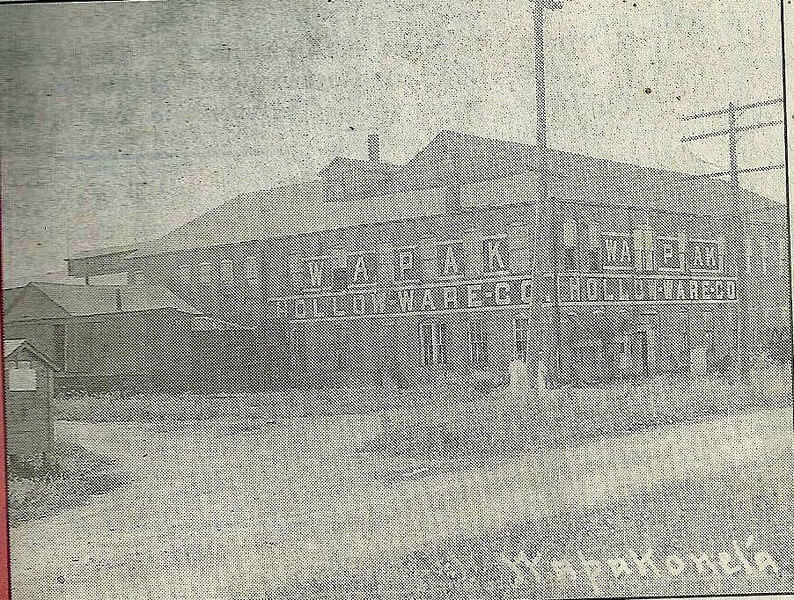
http://www.letstalkbbq.com/index.php?topic=19653.0
What Makes Wapak Cast Iron Different?
If you are starting out collecting vintage cast iron, you might want to consider Wapak ironware. Sure, you can collect cast iron from the big players such as Griswold and Wagner. But did you know Wapak also has a large group of loyal collectors?
Wapak manufactured a wide range of cookware. And in my humble opinion, it has a lot of character and personality. Luckily, a lot of Wapak cast iron available tends to be cheaper than some of the other manufacturers.
Here Is Why You Should Purchase Antique Wapak Ironware.
- The ironware might have a ghost mark.
- Wapak ironware tends to have smooth cooking surfaces
- Wapak cast-iron cookware is lighter than its modern counterparts
- Imperfections in the exterior give the cookware a real sense of personality.
- Some logos are very scarce, making collecting a lot of fun.
Markings On Wapak Cast iron.
Does Your Pan Have A Lighter Embossed Mark?
Can you see words slightly imprinted on your Wapak cookware? Yes, This is an oversight in the casting, but collectors highly prize this flaw. It is commonly known as a ghost mark. A ghost mark is another manufacturer logo or wording on the base of the skillet or cookware. It is not uncommon to see Erie lightly embossed on Wapak skillets.
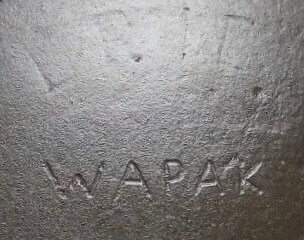
Why Does Some Wapak Ironware Have Ghost Marks?
- Wapak may have bought and used old molds from other foundries
- Wapak may have used other manufacturers’ pans and used them as a template to make their pans
Using another company product as a template is a very questionable practice in the business world. However, copying ideas or designs is sadly still evident today.
If Wapak Hollow Ware did copy a leading manufacturer at the time, surprisingly, they did not try to cover up their efforts better. It may be the case that Erie skillets were so good that Wapak did not mind letting consumers know they were using Erie designs.
WAPAK SKILLETS WITH ERIE MARKINGS ARE VERY COLLECTABLE. THESE MARKINGS ARE CALLED GHOST MARKS AND ARE HIGHLY SOUGHT-AFTER BY COLLECTORS.
Boonie Hicks
The Cookware Will Be Lighter And Smoother Than Most Cast Iron Made Today.
Wapak cast iron, like other vintage iron cookware made during the time, tends to be lighter due to the manufacturer making cookware thinner than it is today. If you think cast iron cookware is heavy, then a vintage/antique skillet could be what you need.
Although Wapak may not be a household name, they made fantastic glassy smooth cast-iron cookware.
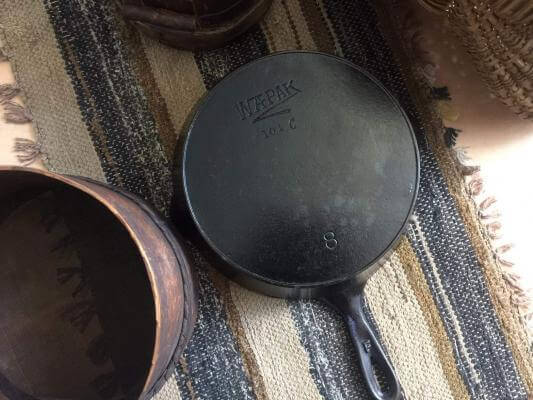
Wapak Cast Iron May Have Imperfections, But That’s Why It Has Character.
If you collect or search for Wapak cast iron, you may notice more casting flaws than other manufacturers. It is not uncommon for Wapak skillets or kettles to have casting bubbles on the base. Or a noticeable ripple due to sand shift during casting. For some, this is an obvious flaw. But for others, it adds to the charm and characteristics of yesteryear pans.
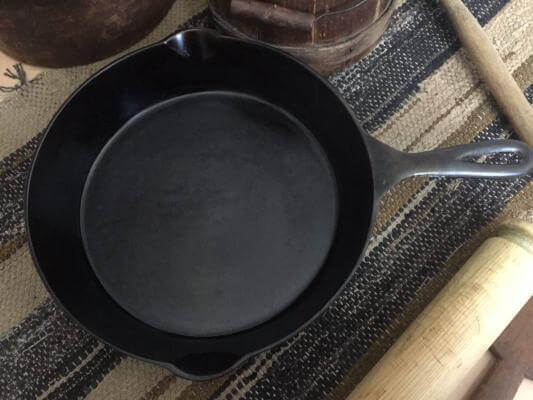
Wapak Hollow Ware Co. Logos And Markings.
Wapak cast iron has various logos or markings, which can indicate age and rarity. Currently, there are seven variations of the logo. Of the seven markings, six use a Wapak logo. The seventh logo is Oneta. Oneta cookware, at the time, was a lower-grade or budget-friendly brand.
Wapak Indian Head Logo: Circa 1903-1926
The most collectible and valuable Wapak logo is the Indian medallion, Native American, or Indian Head. It is a highly detailed logo. However, expect to pay a pretty penny if you come across one. Because of the age of the ironware, it’s not uncommon for the detailing on the logo to be less chrisp due to use.
If you want to learn more about the Indian Head logo, click the link.
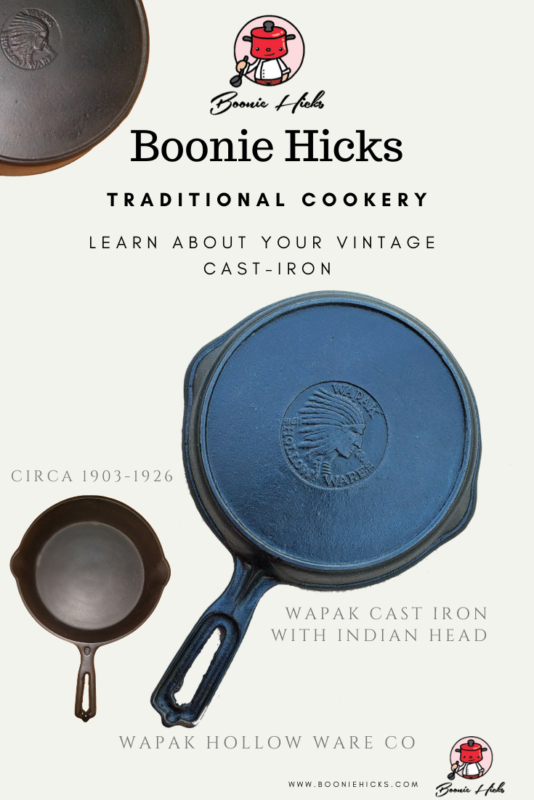
Wapak Chicken Foot Logo: Circa 1903-1910
After the Indian Head, the next most sought-after logo among enthusiasts is the Chicken Foot. Note the splitting at the foot of the P.
Keep an eye out for this marking. It’s seldom seen on Wapak ironware and is probably the scarcest of the Wapak logos.
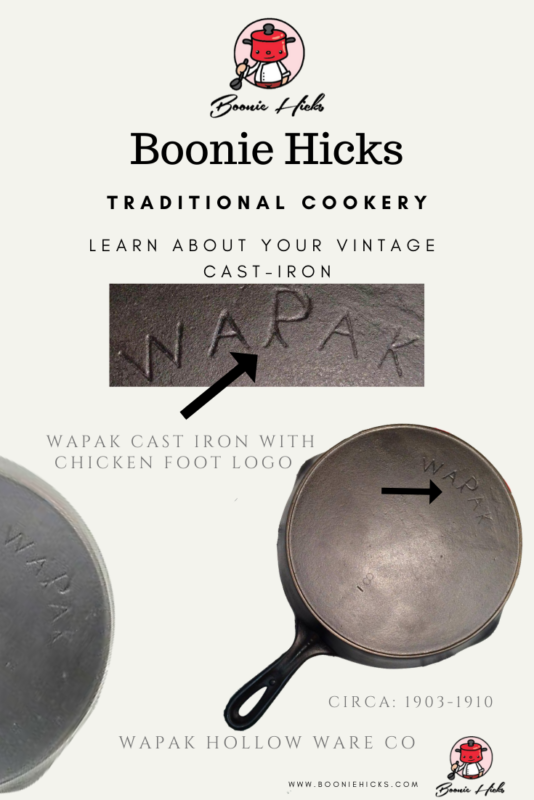
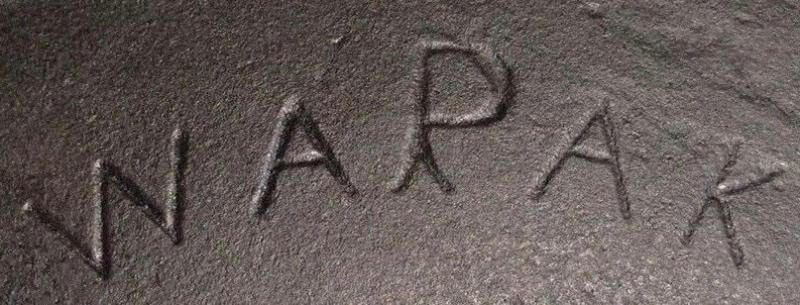
Wapak Arc Logo: Circa 1903-1910
The logo has Wapak in block lettering and is in a slight arc.
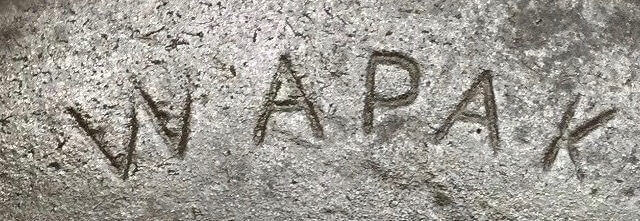
Wapak Straight Block Logo: Circa 1903-1910
The logo is in straight-block lettering. The placement of this can vary from near the top to the center of the cookware. It can also be slightly above or below the center. See the examples below to identify your Wapak.
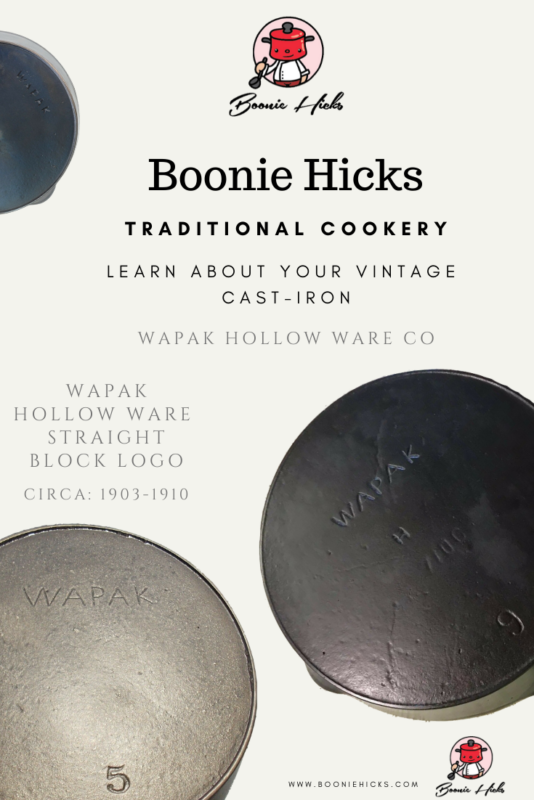
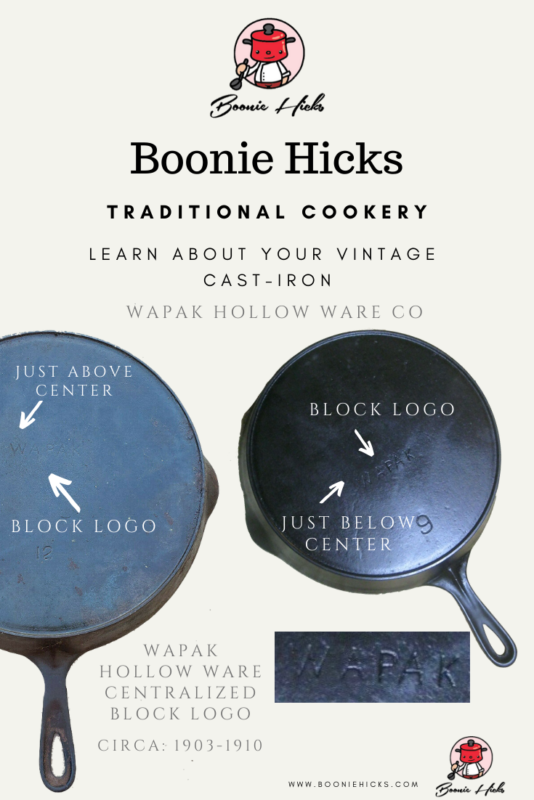
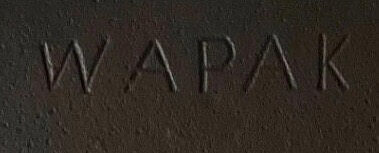
Wapak Z Logo: Circa 1903-1926
This logo has characteristic styling. The most notable feature is the Z appearance.
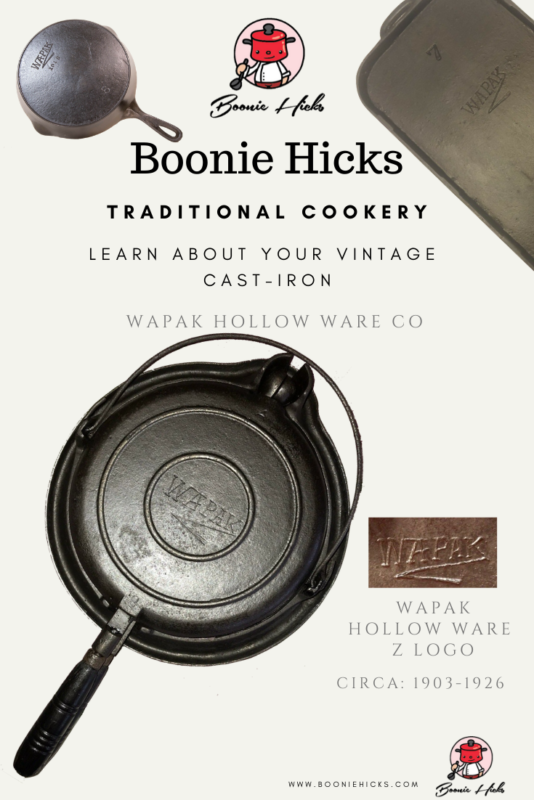
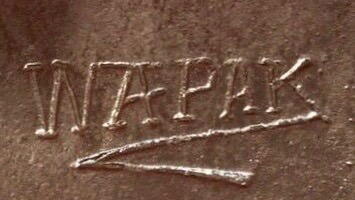
Wapak Tapered Logo: Circa 1912-1926
The logo tapers inward. The Wapak wording is more prominent at the start, and the letter W is noticeably in a larger font. And the tapers inward, decreasing in size. The final letter, K, is notably smaller than the first letter.
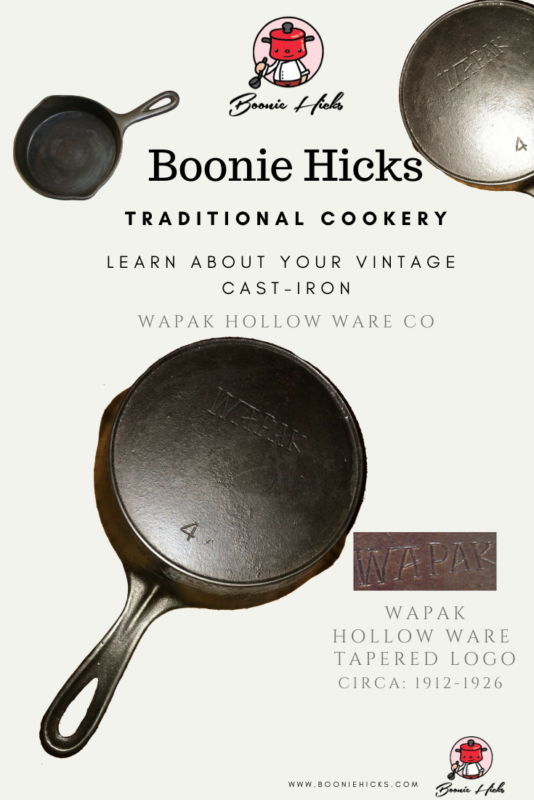
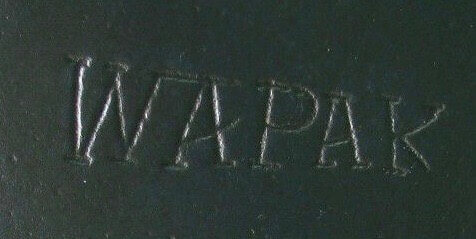
Oneta Marking: Circa 1912-1926
The word Oneta is straight in block writing.
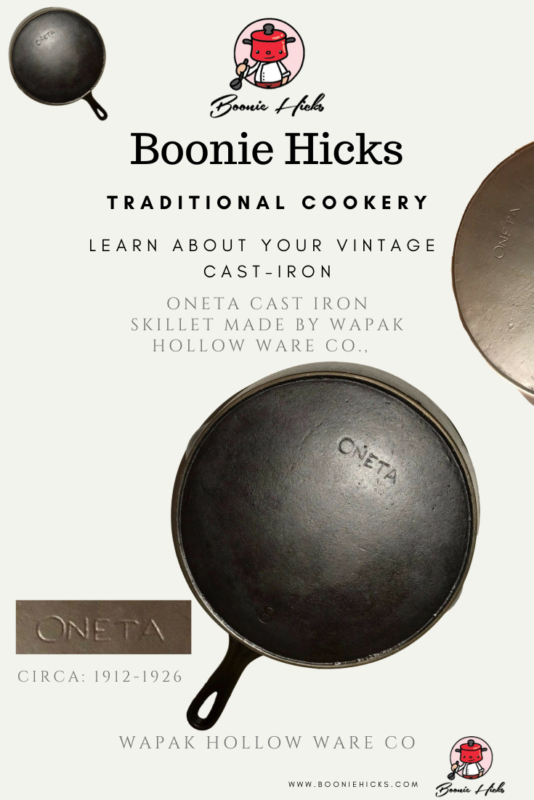
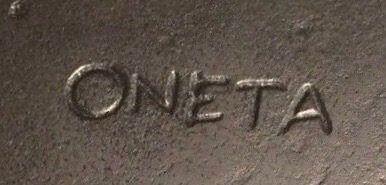
Unknown Marking
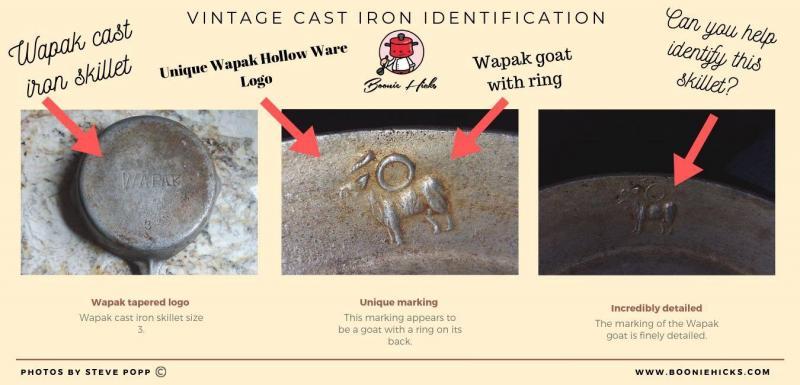
Collecting Wapak Cast Iron Siillets And Kettles.
I have only one Wapak skillet, so I certainly can not call myself an authority on collecting Wapak cast iron. However, it has an ultra-smooth cooking surface, which is just as smooth as my Griswold and Sidney Hollow Ware skillets. The Wapak skillet has the Z logo stamped into the iron. It also has a heat ring around the outside.
Considerations When Collecting Wapak Cast Iron
- Wapak tends to have more cast or molding flaws, which can add to the character. However, for many, it detracts from desirability.
- Wapak cast iron can have very smooth cooking surfaces.
- Ghost marks are common in Wapak Hollow Ware cast iron. Check the base for Wagner or Erie lightly embossed on the iron.
- Like much vintage or antique cast iron, it may be necessary to check or ask how stable the iron sits on a flat surface. Does it rock or spin? Movement in the cookware will negatively affect the value of vintage cast iron.
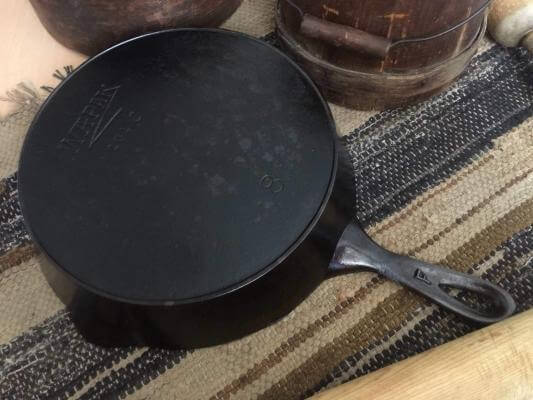
Wapak Hollow Ware Co.
Although Wapak cast iron can be super smooth, many skillets have casting flaws or bubbles in the ironware.
Signs indicate that Wapak foundry used Erie and Wagner cast iron templates or molds to make their cookware. Why did they use foundries, molds, or pans as a template? Wapak employees were skilled at making iron cookware because they had one of the most detailed logos on vintage cast iron, the Indian Head. So it’s surprising to know they used a mold from another company.
And keep an eye out for host marks and those fancy Indian headpieces. They sure are good-looking pans.
Happy cast iron hunting.


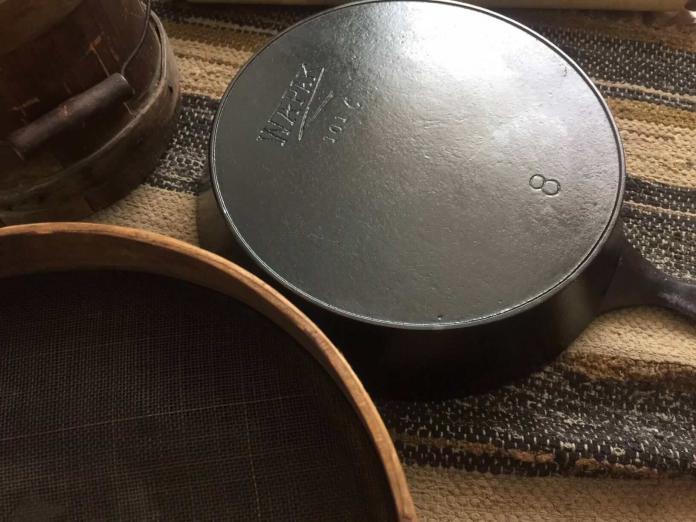
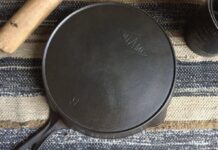
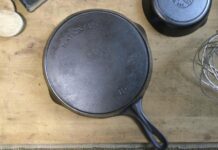
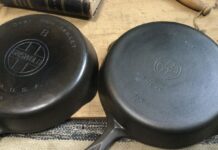



I am a volunteer at local thrift shop and someone donated a Wapak Dutch oven #6 with straight block logo. Any idea what it is worth. Will be listing on eBay.
Hi Jayne
Wapak Dutch Ovens are not scarce, but they don’t come into the market too often. And it may attract more attention than other brands. eBay sold listing should give you an idea of the current value. Vintage Dutch ovens vary a lot depending on the condition. Collectors prefer Dutch ovens that sit flat without any rock or wobble.
Good luck with the listing.
Hi Jayne – I’m interested in buying this. Did you sell? Thanks!
I enjoyed this article. There is a possibility that my great grandfather, George Trautman may have been associated with this company. Are there any records to confirm?
Hi Robin
That’s brilliant that you may have a family connection to the foundry. Unfortunately, I do not know the names of the workers in the foundry. The work certainly would have been grueling. But I guess rewarding at the same time.
Thanks for getting in touch
I have a Wapak #5 pot. It appears to be the 1903 to 1910 with the curved name and no chickens feet. It almost seems to have been painted as it is shiny in places and pitted.
Did they ever put a coating on their pots or do you think this was added by someone who used it as a decorative pot?
Hi David
Your pot could be chrome plated. Chrome-plated pieces are difficult to season and often appear shiny even with serval layers of seasoning. I haven’t come across plated Wapak before, but I’ve seen a few online. So there are out there.
I hope this helps
Hi,
I was at an auction a couple months back where they offered up a 7 and 8 Indian Head. They were essentially the same diameter size. I believe they were made in different years. Possibly a difference in handles also…my 8 handle differs from my 9. Can you provide insight?
Thanks,
Joe
Hi Joe
Congratulations on winning the auction. Wapak skillets with the Indian logo certainly have seen an increase in value over the last few years.
That’s interesting the two skillets are similar in diameter. I know of two slight variations of the handle. One has a flatter recess in the handle and is considered the older of the two variations. The second has a pronounced hollow on the back of the handle and is likely to be a later design.
I hope this helps.
Hi Boonie,
I have a #3 skillet marked Wapakoneta, Ohio. It has with a double AA with arrow through logo any identification ideas?
Hi Larry
It sounds like you have a skillet made by Ahrens and Arnold. Made in the late 1920s by former employees of the Wapak Hollow Company.
There are not many examples around, well done.
Did Wapak ever make a #9 skillet with a round handle??
I can send you pictures if you’d like, for some reason I can’t paste them in this box.
Hi Shawn
I’d love to see a picture. Here’s my email booniehicks@gmail.com
Cheers
We have a #11 Wapak cast iron skillet with the Indian head medallion. Any idea what it is worth?
Hi Betsy
Thanks for your question.
You’re very lucky to have a Wapak with Indian head medallion. Skillets with this logo are highly sought-after by collectors, and skillets can sell for hundreds of dollars. Although, I must add there are fakes on the market. However, these tend to be poor copies of the original.
You might want to compare your skillet with the ones sold on eBay for an indication on value. Collectors will pay higher prices if the skillet is in good condition and sits flat. And the detail of the logo greatly affect value. If the face and headdress is detailed, and writing clearly readable, I would expect your skillet to be worth a pretty penny.
Congratulations
Hello: We have a 9″ Wapak “Z” cast iron pan (used almost daily!) that was my grandmother’s. But it has a layer of rust on the bottom. Is there an easy or safe way to clean that without hurting the integrity of the pan?
Also, we just found a Wagner Ware Sidney -o- skillet while cleaning out my parent’s house. Score for us.
Thanks.
Hi Barry
It’s really nice to hear from you.
I’m sure your grandmother is so happy that you’re treasuring her old skillet. I think the best way to remove rust is using the vinegar method. Unfortunately, I don’t currently have an article on the site. But there’s some very good videos on YouTube. Just search “how to remove rust from cast iron using vinegar.” This method works well, and it’s gentle on the iron surface.
Have fun restoring your skillet and nicely done finding a Wagner. That’s what I call a good day.
Cheers.
Hi Barry. I have several Griswold pans that had rust. I scrubbed them with a little water and coarse salt. When clean, rub them with a little oil and I put them on my outdoor grill on high for a little bit to season them. Hope this helps.
I’m not an expert either, let’s start with that.
I’ve been cooking with and trying to learn of early 20th century cast iron for probably 15 years now.
I want to thank you for your contribution. Every site before this one was maddening to find and even tougher to decipher. Yours is clearly laid out and easy to figure.
In your picture of the “Wapak block logo” there’s a 710c marking. My everyday skillet is that same #9. The 710c is a marking from the old Erie molds, as mine has the very faint “Erie” ghost-mark as well.
I’ve cooked with numerous cast iron over the years and the Wapak #9 I’m speaking of blows away the many Griswold’s I’ve owned. If it boils down to pure performance, as it does for me. Or collectibility…Wapak might be the way to go either way.
Hi there Joseph
I’m really pleased you’re getting a lot of use of your Wapak. Like you, I think Wapak cast iron is just as good as Griswold. And best of all collectors these wonderful pieces at lower prices.
Thanks, I’m glad you’ve enjoyed the article. Hopefully there will be a few more in the coming months.
Cheers, have a good day.
Found a Wapak Ghost Indian Head #5 skillet great condition , what do you think ?
I think it’s your lucky day
Before putting in an offer check to see if the skillet sits flat or if it has a bow. I’d also check the sold listings on eBay to compare the sellers asking price. But otherwise congratulations, it sounds like a great find.
Good luck Steve
I have a wolf pack Skillet number 6 and it appears to be made out of steel do you have any information on it?
Hi Don
Thanks for your question.
Wow how wonderful. Unfortunately, I don’t have any information on your Wapak skillet. It sounds like a real beauty and a lot of collectors would like to get their hands on it. You’re welcome to send over a couple of pictures of your have time. I’d love to see what it looks like. booniehicks@gmail.com
Hopefully another collector might be able to share some information on it.
Cheers, for your question
Greetings,
Thanks so very much for providing this wealth of knowledge. I have gained an interest to WAPAK as I have collected a handful of these vintage treasures. Do you have a source of manufacturing dates of the different logos WAPAK made?
Thanks in advance!
Hello Lloyd
Thanks for the comment, I’m really glad you’ve found the article interesting. Your suggestion of dates is well worded and will greatly help those wanting to identify and date their vintage Wapak ironware. I’m just finishing another article and then I’ll add some dates to the article over the next couple of weeks.
Many thanks
Really enjoyed your article. Thank you for sharing your knowledge. I have a WAPAK 7 oblong griddle. I can’t find any info on such a piece. Is it a griddle or a sad iron. My curiosity is peeked.
Hi Sandi
Thanks for letting me know you enjoyed the article.
It sounds like you have a Wapak long griddle probably made around 1903-1926. Cast iron trays used for heating sad irons are small and probably made in the 19th century. I’d most people heated their sad irons on a wood stove or stood them upright next to a fire.
Enjoy your Wapak
Hello. Thank you for the history of the Wapak Hollow Ware Company. I was wondering if you had any information on the lawn furniture they made. I have an edwardian-style cast iron bench made by the company in the 1920’s. I actually have the ad they used to advertise the settee which they priced at a whopping $11.50! Can you direct me to anyone who might help me value this piece? Or find a buyer?
Thank you.
Hi Christine
I’m glad you enjoyed the article and thank you for sharing the information on your Wapak cast iron bench. It seems the dollar stretched a bit further back then.
I recommend you contact an antique dealer or auction house in your area. The value on cast iron furniture can vary greatly, benches from the Coalbrookdale foundry can be worth a pretty penny while others not so much. However, an antique dealer should be able to point you in the right direction on the value and how to sell your bench for the best price.
Thanks for the contact.